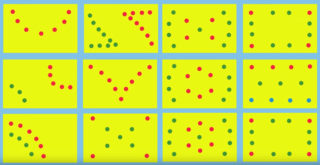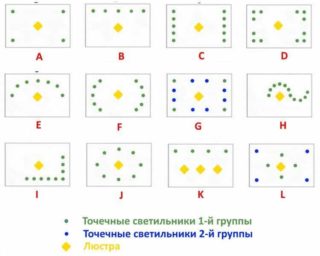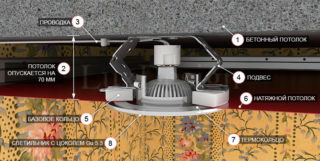Increasingly, ceilings are finished not with classic wallpaper or water-based paint, but with a stretch canvas. This design is versatile and extremely attractive. LED strips and halogen lamps are used as lighting devices. The most popular are spotlights. To correctly make point lighting of stretch ceilings, you need to take into account the purpose and layout of the room.
Spot lighting features
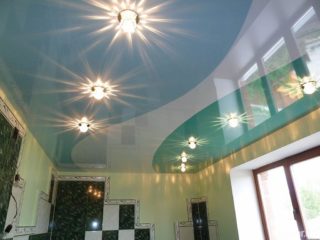
When arranging lighting on a suspended ceiling, do not forget that it is forbidden to attach any objects to the surface of the canvas. The canvas is made from a fabric base or PVC film. The latter option is used much more often. Such a film does not have a high level of strength and heat resistance. Lighting fixtures with traditional incandescent lamps cannot be installed in a stretch ceiling, there is a risk of melting the area next to the lamp.
With the help of point light, you can accentuate any interior items. The geometry of the rectangular rooms will be emphasized by a row of light points. They can be installed both along the entire perimeter and along only one wall.
Spotlights can be mounted at the level of the canvas or protrude slightly above its plane. Both methods are effective. the soft and diffused glow of spotlights will be relevant in lounges. To make a composition on the ceiling or to highlight a door arch, use a dim light.
Each light point has an adjustable luminous flux, which allows you to accentuate the workplace, kitchen countertops or a table in the living room.
The suspended ceiling conceals a few centimeters of the room's height. You can visually raise it using spot lighting. If the light streams are directed upwards onto the canvas, the ceiling will appear higher than it actually is. This effect is especially noticeable on glossy vinyl canvases.
Types of lamps
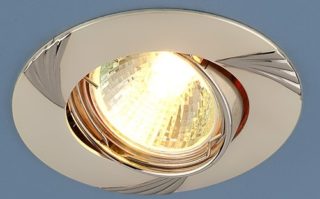
The market offers many types of lighting equipment. Lighting under a stretch ceiling differs not only in the design and type of lamp, but also in design features:
- According to the method of installation, lighting devices are divided into pendant-type chandeliers, overhead and built-in devices.
- According to the number of light points, the luminaires are divided into cascade and point ones.
- If it is possible to adjust the luminous flux, models of a static type and a rotary one are distinguished.
- According to the light source, LED, halogen and fluorescent lamps are distinguished.
Spot illumination makes it possible to find unusual light variations. You can emphasize the interior design or zoning the room.
When choosing light points for suspended ceilings, you need to pay attention to such a parameter as their the size, or rather, height. This characteristic determines how far the ceiling frame will have to be lowered. In the conditions of the arrangement of the apartment, where the ceilings are not very high, this is extremely important. The optimum height of the spotlight will be 4-6 cm.
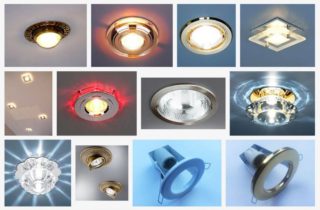
By form spotlights are presented in a huge variety. They are:
- round;
- oval;
- square;
- rectangular;
- diamond-shaped.
Each model of a light point, regardless of its shape, can be with or without a rim.The former protrude above the ceiling plane, and the latter are flush with the canvas.
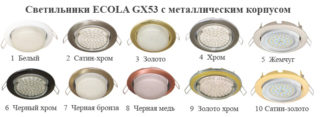
The spot light can be made from the following materials:
- brass;
- metal;
- thermoplastic;
- glass.
To give it a stylish look, the lamp is covered with all kinds of finishing materials - from wood to gold.
Color spectrum spotlights are truly wide. The device can be painted in absolutely any color:
- any color from the existing color palette (red, white, blue, etc.);
- wood color;
- metallic colors - gold, copper, brass, bronze, silver and others.
Choosing a device for the style of the interior and creating your own lighting design will not be difficult. Any design decision will be implemented.
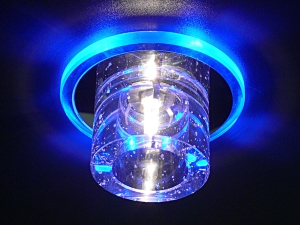
Spotlights are like this power:
- LED - from 2 to 20 W;
- halogen - 5-60 W;
- luminescent - from 5 to 50 W.
For suspended ceilings, the power of halogen lamps should not exceed 40 W, fluorescent - 50 W, LED - 12 W (for seamless ceilings - 18 W).
Location of lighting points
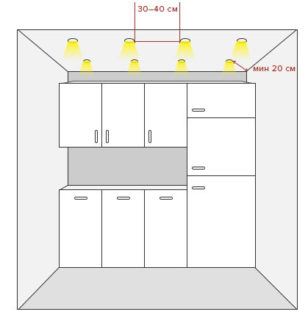
Spot lighting devices are arranged in this way: 1 light point for 1.5-2 m2. For example, in a room with an area of 15 m2, it is optimal to integrate 10 lamps. Also, when placing, you need to take into account the power characteristics of the lamps and the purpose of the room. Perhaps additional sources of lighting will be used, for example, chandeliers. Attention should be paid to the dimensions of the lamps: the larger they are, the greater the distance should be between them. The average recommended distance is 30 cm.
The places of the lamps are distributed so that they are not close to the baguettes. The maximum allowable distance between the baguette and the light point is 2.5-3.0 cm.
The location of the light points must be determined even before the installation of the ceiling sheet. This is especially important for multi-level ceilings, where each of the tiers is distinguished by an individual lighting contour.
Spot lighting of various rooms
In stretch ceilings, lighting is mounted according to the following main schemes:
- Parallel arrangement in 2 or more lines is a perfect scheme for long rooms with a narrow passage, for example, a corridor.
- Rectangular placement - visually makes the room larger and fits well with the chandelier in the center. Suitable for the hall.
- Checkerboard layout - great for rooms with an "island" where bright lighting is required in the corners and in the center, for example, a kitchen.
- Arched configuration - makes it possible to accentuate a specific part of the room, for example, a recreation area or a step in multi-level ceilings. Suitable for the bedroom.
- Chaotic arrangement of lighting fixtures - well suited for asymmetrical rooms where furniture is arranged in a non-geometric order, for example, a living room.
- The cruciform arrangement is an excellent configuration for small interiors, for example, a children's room, where the installation of large-sized chandeliers and pendant lamps is impossible.
- Square variations without a central lighting fixture - a utilitarian and optimal scheme for the bathroom.
- Arranging the light points in one row is the easiest way for small rooms, for example, a balcony.
For stretch ceilings, as a rule, they choose lamps with LED or halogen-type lighting sources, very rarely - fluorescent ones. Energy consumption and heating of LED luminaires is minimal. Accordingly, the risk of yellowing and melting of the ceiling sheet is also minimized. In this case, the brightness of the lighting does not suffer at all.
Spot-type luminaire bodies can be completely built into the ceiling sheet, or they can protrude slightly beyond its plane, which contributes to better heat dissipation. The latter are preferable for installation in rooms with low ceilings. They minimize the distance between the base and the ceiling fabric.
Spot lighting makes it possible to implement any design solutions, even if the room is not large. These are possibilities without borders. You can accentuate specific details of the interior, carry out zoning and use any lighting scenario.

